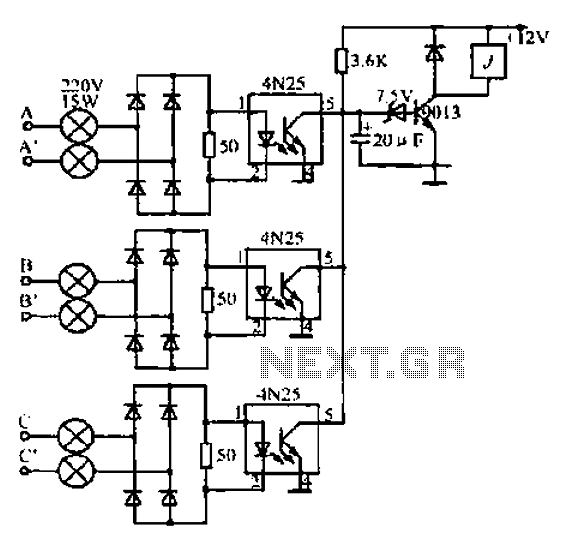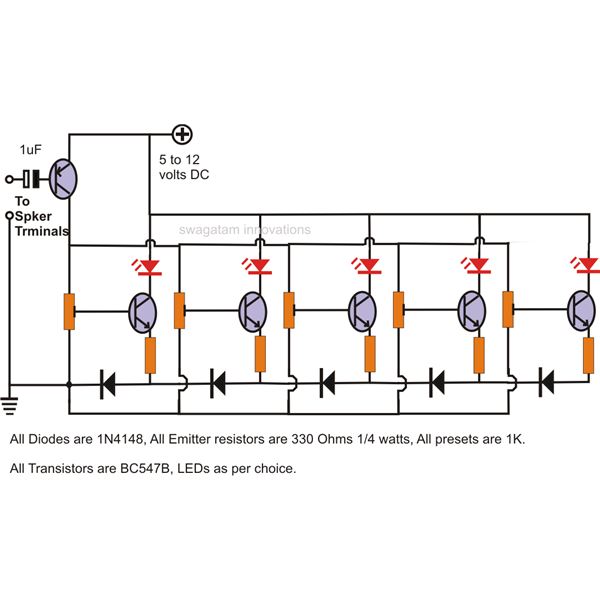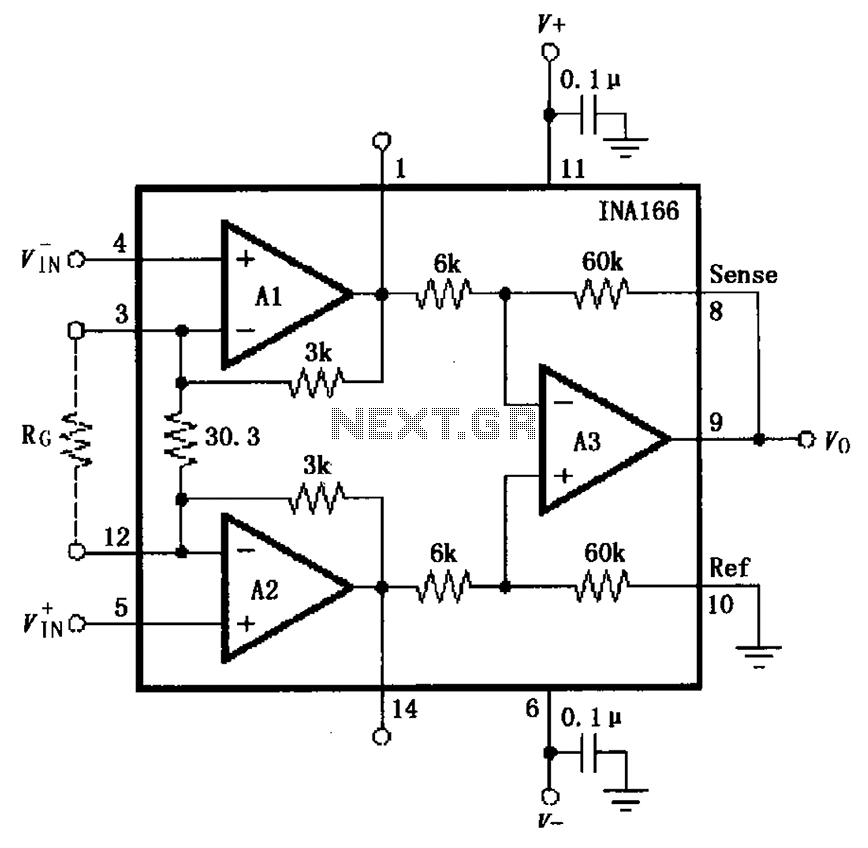
Crank Doorbell Circuit Schematic

An interesting hobby circuit of a crank doorbell. The circuit is built around a 555 timer and a musical piezo buzzer. It operates using a 9-volt battery supply; a single 9-volt PP3/6F22 compact battery is sufficient to power the entire device. The timer IC (NE555) is configured in monostable mode to produce a timeout of several seconds. The output from the timer is directed to the input of the piezo sounder through a diode D1. Capacitor C2 functions as a buffer. The resistor-capacitor (RC) components R2 and C1 determine the timeout duration of the NE555 timer. A small low-voltage DC motor is utilized as a crank switch, with a small disc motor sourced from a discarded CD drive (optical deck) used in the prototype. Even minimal rotation of the motor shaft generates enough counter electromotive force (emf) to energize the LEDs inside the AC opto-coupler PS2505. Consequently, the phototransistor within the PS2505 conducts, pulling down the trigger input (pin 2) of the NE555 IC. The result is a loud yet pleasant musical tone output from the piezo sounder for a finite duration, approximately several seconds. The musical buzzer can easily be replaced with an electromagnetic relay for switching external loads, with a 9-volt/600-ohm relay preferred for this modification. The circuit can also function as a two-wheeler security aid that detects the wheel rotation of a parked vehicle and sounds an alarm to alert the owner. With some skill, the crank mechanism (such as a dynamo-wheel assembly) can be attached to any vehicle. However, for burglar alarm applications, a latching output circuit is highly recommended.
The crank doorbell circuit is an engaging project that combines basic electronics with practical applications. The NE555 timer, a versatile integrated circuit, is the heart of this design, providing precise timing functions. In monostable mode, it generates a single output pulse in response to a trigger signal, which in this case is provided by the crank switch mechanism. The timing interval is adjustable by changing the values of the resistor R2 and capacitor C1, allowing customization of the duration of the musical tone produced.
The use of a piezo buzzer offers an efficient way to generate sound, as it requires minimal power while producing a clear tone. The addition of diode D1 protects the timer circuit from back EMF generated by the buzzer when it is turned off, ensuring reliability and longevity of the components. The buffer capacitor C2 stabilizes the voltage supplied to the buzzer, enhancing the quality of the sound output.
In terms of the crank switch, the small DC motor acts as a generator when its shaft is rotated, producing the necessary voltage to activate the opto-coupler. The PS2505 opto-coupler isolates the timer circuit from the motor circuit, providing safety and preventing noise interference. The phototransistor's conduction state allows the timer to be triggered, demonstrating a practical application of electromechanical energy conversion.
For those looking to expand the functionality of this circuit, replacing the piezo buzzer with a relay opens up possibilities for controlling larger devices or integrating the circuit into a home automation system. The suggested 9-volt relay can switch higher power loads, making it suitable for various applications beyond just a doorbell.
Furthermore, the circuit's adaptation as a security device for two-wheelers showcases its versatility. By attaching the crank mechanism to a vehicle's wheel, the circuit can detect motion and activate an alarm, providing an additional layer of security. The recommendation for a latching output circuit in burglar alarm applications emphasizes the need for a reliable and persistent alert system, ensuring that the alarm remains active until manually reset.
Overall, this crank doorbell circuit exemplifies a fun and educational project that illustrates fundamental electronic principles while offering practical uses in everyday life.An interesting hobby circuit of a crank door bell! The circuit is built around a timer 555 and a musical piezo-buzzer. The circuit works off 9 volt battery supply. One 9volt PP3/6F22 compact battery is enough for powering the whole gadget. Timer IC (NE555) is wired in monostable mode to produce a time out o some seconds. The output of t he timer is fed to the input of the piezo sounder through a diode D1. Capacitor C2 works as a buffer. RC components R2, C1 sets the monotimeout of the timer IC NE555. An ordinary low voltage small dc motor is here used as the crank switch. In prototype, one small disc motor from a discarded cd drive (optical deck) was used. Even a slight rotation of the motor shaft will produce sufficient counter emf to enegize the LED(S) inside the ac opto-coupler PS2505. As a consequence, phototransistor inside PS2505 conducts and there by it pull down the trigger input (pin2) of IC NE555.
The result is a loud but pleasing musical tone output from the piezo sounder for a finite duration, here around seconds. One can easily replace the musical buzzer with an EM relay for switching external loads. A 9 volt/600 Ohm relay is preferred for this modification. The circuit can also be used as a two wheeler security aid which senses the wheel rotation of a parked vehicle and sounds an alarm to alert the owner.
With a little skill, one can easily attach the crank mechanism (like the dynamo-wheel assembly) to any vehicle. However, for burglar alarm application, a latching output circuit is highly recommended. 🔗 External reference
The crank doorbell circuit is an engaging project that combines basic electronics with practical applications. The NE555 timer, a versatile integrated circuit, is the heart of this design, providing precise timing functions. In monostable mode, it generates a single output pulse in response to a trigger signal, which in this case is provided by the crank switch mechanism. The timing interval is adjustable by changing the values of the resistor R2 and capacitor C1, allowing customization of the duration of the musical tone produced.
The use of a piezo buzzer offers an efficient way to generate sound, as it requires minimal power while producing a clear tone. The addition of diode D1 protects the timer circuit from back EMF generated by the buzzer when it is turned off, ensuring reliability and longevity of the components. The buffer capacitor C2 stabilizes the voltage supplied to the buzzer, enhancing the quality of the sound output.
In terms of the crank switch, the small DC motor acts as a generator when its shaft is rotated, producing the necessary voltage to activate the opto-coupler. The PS2505 opto-coupler isolates the timer circuit from the motor circuit, providing safety and preventing noise interference. The phototransistor's conduction state allows the timer to be triggered, demonstrating a practical application of electromechanical energy conversion.
For those looking to expand the functionality of this circuit, replacing the piezo buzzer with a relay opens up possibilities for controlling larger devices or integrating the circuit into a home automation system. The suggested 9-volt relay can switch higher power loads, making it suitable for various applications beyond just a doorbell.
Furthermore, the circuit's adaptation as a security device for two-wheelers showcases its versatility. By attaching the crank mechanism to a vehicle's wheel, the circuit can detect motion and activate an alarm, providing an additional layer of security. The recommendation for a latching output circuit in burglar alarm applications emphasizes the need for a reliable and persistent alert system, ensuring that the alarm remains active until manually reset.
Overall, this crank doorbell circuit exemplifies a fun and educational project that illustrates fundamental electronic principles while offering practical uses in everyday life.An interesting hobby circuit of a crank door bell! The circuit is built around a timer 555 and a musical piezo-buzzer. The circuit works off 9 volt battery supply. One 9volt PP3/6F22 compact battery is enough for powering the whole gadget. Timer IC (NE555) is wired in monostable mode to produce a time out o some seconds. The output of t he timer is fed to the input of the piezo sounder through a diode D1. Capacitor C2 works as a buffer. RC components R2, C1 sets the monotimeout of the timer IC NE555. An ordinary low voltage small dc motor is here used as the crank switch. In prototype, one small disc motor from a discarded cd drive (optical deck) was used. Even a slight rotation of the motor shaft will produce sufficient counter emf to enegize the LED(S) inside the ac opto-coupler PS2505. As a consequence, phototransistor inside PS2505 conducts and there by it pull down the trigger input (pin2) of IC NE555.
The result is a loud but pleasing musical tone output from the piezo sounder for a finite duration, here around seconds. One can easily replace the musical buzzer with an EM relay for switching external loads. A 9 volt/600 Ohm relay is preferred for this modification. The circuit can also be used as a two wheeler security aid which senses the wheel rotation of a parked vehicle and sounds an alarm to alert the owner.
With a little skill, one can easily attach the crank mechanism (like the dynamo-wheel assembly) to any vehicle. However, for burglar alarm application, a latching output circuit is highly recommended. 🔗 External reference





